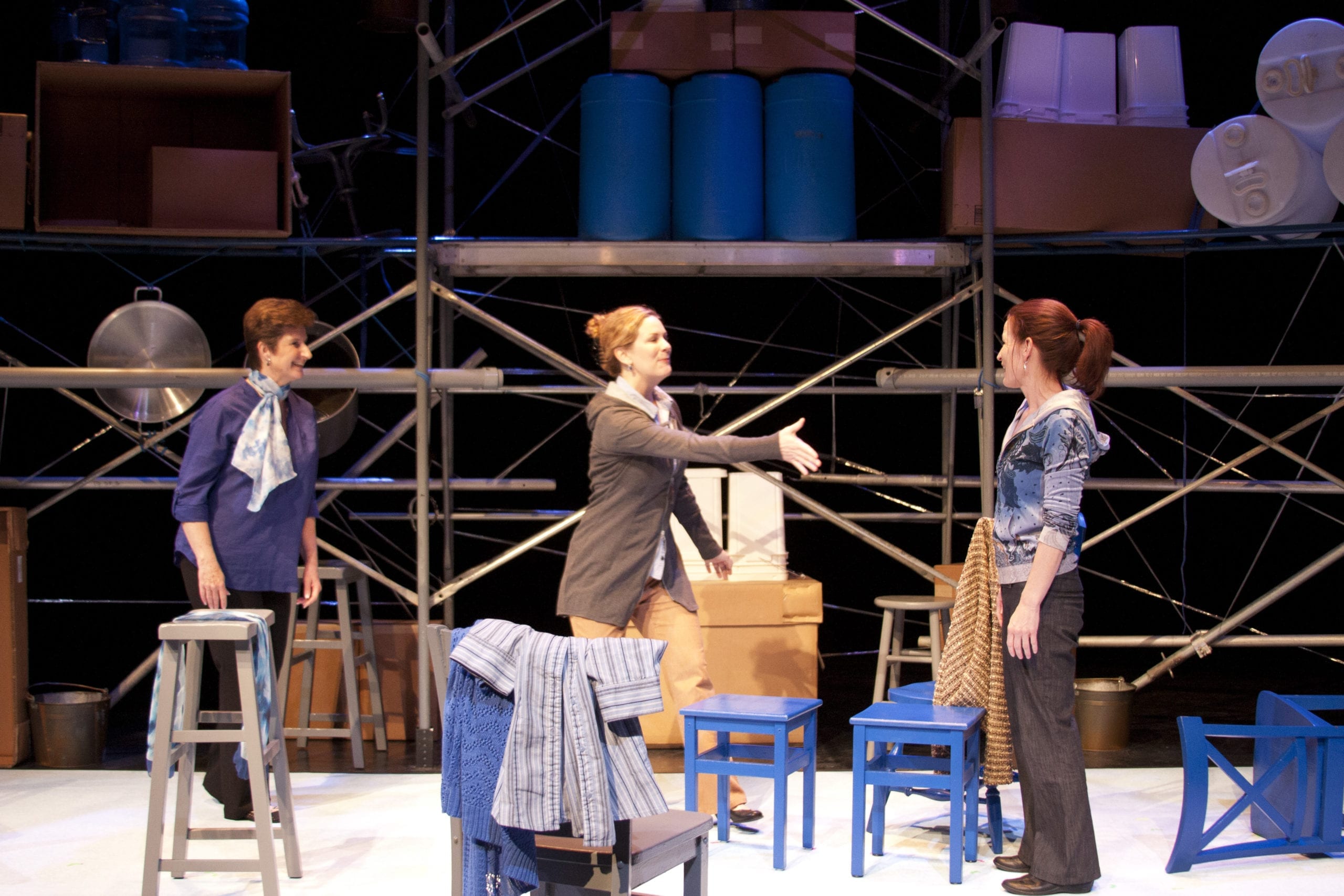SALT LAKE CITY — Plan-B Theatre Company’s ongoing mission to bring socially conscious and locally relevant plays to Utah audiences has produced numerous sold-out shows. The closing production of their latest season—The Season of Eric—is sure to follow that model. 3 by Eric Samuelsen offers three short plays performed by three extremely versatile actresses that focus on the experiences and tribulations of modern LDS women. I think that audiences will find this both a polarizing and thought-provoking evening of theatre.

Photo by Rick Pollock
The first piece, Bar & Kell, shares the story of two women, both upstanding members of the local ward, who make a “project” of the third woman, an inactive and unmarried mother new to neighborhood. I’ll be honest; this piece initially offended and upset me. I felt that the caricatures were over-blown and the story details about the inactive character were ignorant and extreme. True or not, that wasn’t the point. The play is meant to showcase both extreme perceptions about “Relief Society Types” in our communities, how they are either angels armed with phone trees and Swiffers or self-righteous meddlers trying to maintain the property value of their neighborhoods. What was most compelling was the growth of the characters Kelly (Christy Summerhays), who finds the malice in her own attempted benevolence, and Brandie (Stephanie Howell), who seeks improvement of her circumstances through assimilation and acceptance from the church. Teresa Sanderson as both Bar, a determined and unrelenting ward matron, and Aunt Dot, Brandie’s world-weary and anti-LDS protector, provides a strong contrast and a reminder of the dangers of extremes.
Second in the series is Community Standard in which three women meet while on jury duty to decide whether pornography found for rent in a local video store qualifies as obscenity. This felt the most dated and localized of the pieces. I’m not entirely sure that a chance meeting between two women in a Harmon’s years after an obscenity case and using Titanic as an example of quality love would play outside of Utah. That aside, this piece does explore the effects of misogyny and sexism inherent in porn and, in some cases, religion. While I didn’t necessarily find the premise very enthralling, I did appreciate the questions this vignette asked: what is equality? Exploitation? Objectification? How do religious women reconcile the expectations of the physical with the commandments of the spiritual? And vice-versa? Howell as the character of Janeal, an attractive, dutiful, and stifled wife, stood out in this piece. She very effectively communicated the multi-faceted struggle women like Janeal face, and the choices they make about their marriages—out of naiveté, obligation, or fear—that other women simply can’t understand. These strong thematic elements tap into local and current events like the very hot topic of women’s rights within the LDS church and will most likely deeply resonate with the intended audience.

Photo by Rick Pollock
The evening closes with Duets, the most complete and moving story. Sondra (Summerhays) and her husband are new to the ward: when they attend they are choir superstars, when they don’t, speculation abounds. Sherilynn (again, a lovely turn by Howell), longing for beauty in her life, cultivates a friendship with the angel-voiced and accomplished Sondra but is then faced with the reality that not everything about her new friend is beautiful. Sondra is married to Mark: dashing, musically gifted, universally admired, and gay. Sanderson as Candace the choir director exemplifies the kindness, well-meaning, and utter obliviousness to difference that is easily recognizable in many church-centered communities. The most interesting thing about the unfolding events is that while Candace has only a shallow interest in Sondra’s life, she offers compassion unconditionally. Whereas Sherilynn regrets the intimacy and vulnerability in her friendship that caused her idealized version of Sondra and Mark to be obliterated. Summerhays’ Sondra is not the protagonist of Duets, but her performance is the most profound. There is a constant unspoken burden, a sadness, and bittersweet regret to all of her interactions with Sherilynn. When the truth finally comes out, Sondra is sad but changed, more aware about the contradictions between church doctrine and the truths about love. When the climax comes, it’s all the more heartbreaking because of Summerhays’ exposed nerve rendering of Sondra.
Cheryl Ann Cluff ‘s tight, well-paced, and thoughtful direction uses the talents of the actresses ingeniously while keeping a light touch and transitions between plays and characters streamlined. Minimalistic designs by costume designer Phillip R. Lowe and lighting designer Jesse Portillo establish the environment and let the story speak for itself. The set design by Randy Rasmussen is meant to abstractly represent a food storage pantry, which it does but it felt overly large and overwhelming against the grounded and intimate storytelling Cluff created. To me, the most connected and interesting design element was the sound design, also by Cluff, which offered a quietly subversive soundtrack, featuring female folk voices and a smattering of modern versions of LDS hymns.
3 asks for some tough introspection from its audience, serendipitously asked at a time in our state when feminism, equality, tolerance, and change are all increasingly prevalent and significant. All three plays show women who are struggling with the balance (and sometimes the selfishness) of being Christian and being “righteous.” 3 will be a “must see” for many people and tickets are sure to sell fast. There is a lot of truth to the characters that are presented. I think that is why Bar & Kell originally angered me so much. I know what it is like to be a “project.” I have seen that same judgment and pity in well-meaning eyes. Because I was on the other side of the situation, I don’t identify with the story the same way other audience members did and will. That being said, 3 will hit home for many people and it is overall a very well-done production.

Photo by Rick Pollock






